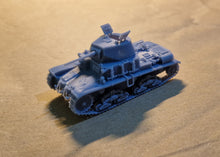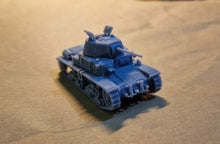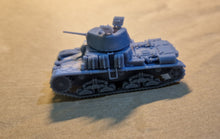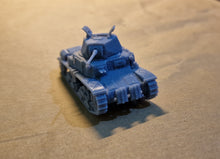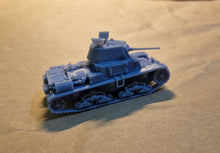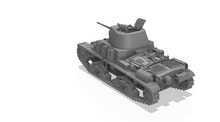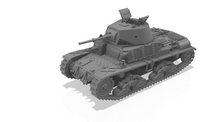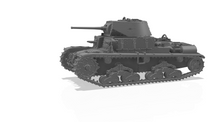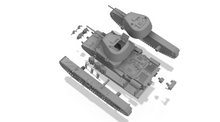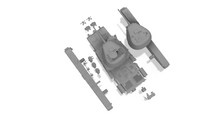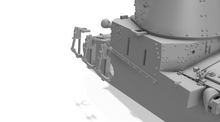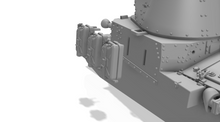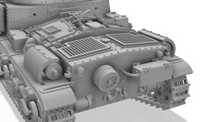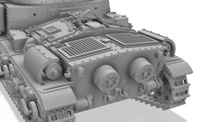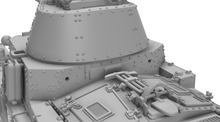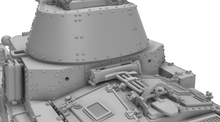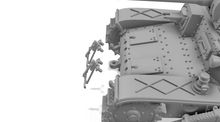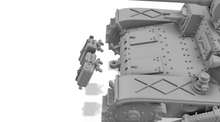
L'M15/42, indicato meno spesso come M.42, è stato un carro armato progettato e prodotto dal Regio Esercito nel pieno della seconda guerra mondiale
Nel luglio 1942, per rimediare alle carenze manifestate dai carri medi allora in servizio, iniziò lo sviluppo di un veicolo meglio armato e con apparato motore a benzina più efficiente. Nel marzo 1943 il prototipo dell'M15/42 fu avviato alla produzione che totalizzò circa ottanta esemplari: armato con un cannone da 47 mm dalla canna allungata fino a 40 calibri rispetto al pezzo montato su M13 e M14, di quei carri ereditava una corazzatura inadatta per metodo costruttivo e di modesto spessore a fronteggiare i mezzi allineati dagli eserciti avversari.
L'M15/42 era caratterizzato dal nuovo armamento in torretta, il pezzo da 47 mm lungo 40 calibri, con superiore velocità iniziale, traiettoria più tesa e gittata maggiore a confronto del precedente cannone pari calibro 47/32 Mod. 1935. La principale granata in dotazione era il modello EP ("effetto pronto"), ovvero una carica cava che raggiungeva 900 m/s: era capace di perforare una corazza spessa 112 mm da 100 metri, spessa 60 mm da 500 metri, 43 mm da 1 000 metri e 24 mm da 2 000 metri. Furono anche fornite granate EPS (stante per "effetto pronto speciale", ovvero proietti HESH) che battevano corazzature spesse 115 mm a prescindere dalla distanza del bersaglio preso di mira. L'armamento di bordo era completato da due mitragliatrici Breda Mod. 38 in casamatta e da una terza Breda Mod. 38 coassiale al cannone, che poteva essere rimossa dal proprio affusto e impiegata in funzione antiaerea.
Il Regio Esercito fece in tempo a immettere in servizio ottantadue carri M15/42 che distribuì all'arma della Cavalleria e dei carristi senza costituire grandi unità, vista la poco numerosa produzione. La gran parte andò in carico alla 135esima Divisione corazzata "Ariete": ciascuno dei tre Gruppi misti componenti il 10° Reggimento di Cavalleria corazzata "Lancieri di Vittorio Emanuele II", facente parte della divisione, doveva avere uno squadrone su 25 M15/42 (gli altri due erano dotati di semoventi da 75/18) e il 10º Squadrone di riserva su dieci carri. Alcune altre formazioni furono equipaggiate con gli M15: il XVIII e il XIX battaglione ebbero ognuno una compagnia su venti carri; il X Gruppo, costituito il 1º agosto 1943 per completare l'organico del 10º Reggimento "Lancieri di Vittorio Emanuele II", non ebbe più di dodici M15/42; ulteriori cinque veicoli trasformati in carri comando formavano il Plotone Carri Centro Radio della 135ª Divisione corazzata. Infine un numero imprecisato di mezzi era in deposito presso il 33º Reggimento carri.
La 135ª Divisione corazzata adoperò gli M15/42 durante la difesa di Roma e gli scontri di Porta San Paolo (8-10 settembre 1943). Un'aliquota di carri fu impiegata dalle forze armate della Repubblica Sociale Italiana così come da varie unità tedesche negli ultimi anni di guerra, dentro e fuori la penisola. Alla fine del secondo conflitto mondiale, diversi M15/42 furono riutilizzati dai reparti del neocostituito Esercito Italiano e dalla Polizia di Stato fino ai primi anni '50.
Il kit in resina Mussini in scala 1/72 permette di costruire versioni differenti dell'M15/42: con o senza fusti di acqua/benzina davanti e sul fianco sinistro, con la seconda ruota di scorta o la cassetta di fumogeni nella parte posteriore dello scafo, con o senza la cassetta di riserva di candelotti dietro alla torretta. Nella confezione sono presenti due torrette, una a sportelli chiusi e l'altra con gli sportelli aperti: è incluso anche il figurino del capocarro.
-----------------------------------------------------------------------------------------------
The M15/42, referred to less often as the M.42, was a tank designed and produced by the Royal Army in the midst of World War II
In July 1942, to remedy the shortcomings of the medium tanks then in service, the development of a better armed vehicle with a more efficient petrol engine began. In March 1943 the prototype of the M15/42 was launched into production which totaled about eighty specimens: armed with a 47 mm cannon with a barrel lengthened up to 40 calibers compared to the piece mounted on the M13 and M14, it inherited an unsuitable armor from those tanks for constructive method and of modest thickness to face the vehicles lined up by the opposing armies.
The M15/42 featured the new turret armament, the 47 mm long 40 caliber gun, with higher muzzle velocity, flatter trajectory and longer range compared to the previous 47/32 Mod. 1935 caliber cannon. The main grenade supplied was the EP model ("ready effect"), i.e. a hollow charge that reached 900 m/s: it was capable of piercing 112 mm thick armor from 100 meters, 60 mm thick from 500 meters, 43 mm from 1,000 meters and 24 mm from 2 000 meters. EPS grenades were also supplied (standing for "special ready effect", i.e. HESH shells) which beat 115 mm thick armor regardless of the distance to the targeted target. The on-board armament was completed by two Breda Mod. 38 machine guns in the casemate and a third Breda Mod. 38 coaxial to the cannon, which could be removed from its carriage and used for anti-aircraft purposes.
The Royal Army had time to put eighty-two M15/42 tanks into service which it distributed to the Cavalry and tank crews without forming large units, given the small number of production. Most of it went to the 135th Armored Division "Ariete": each of the three mixed Groups making up the 10th Armored Cavalry Regiment "Lancers of Vittorio Emanuele II", part of the division, had to have a squadron of 25 M15/42s ( the other two were equipped with self-propelled 75/18) and the 10th Reserve Squadron on ten tanks. Some other formations were equipped with M15s: the XVIII and XIX battalions each had one company on twenty tanks; the X Group, established on 1 August 1943 to complete the staff of the 10th "Vittorio Emanuele II Lancieri" Regiment, had no more than twelve M15/42s; a further five vehicles transformed into command tanks formed the Radio Center Tank Platoon of the 135th Armored Division. Finally, an unknown number of vehicles was in storage at the 33rd Tank Regiment.
The 135th Armored Division used the M15/42 during the defense of Rome and the clashes of Porta San Paolo (8-10 September 1943). An aliquot of tanks was employed by the armed forces of the Italian Social Republic as well as by various German units in the last years of the war, inside and outside the peninsula. At the end of the Second World War, several M15/42s were reused by the units of the newly formed Italian Army and by the State Police until the early 1950s.
The Mussini resin kit in 1/72 scale allows you to build different versions of the M15/42: with or without water/petrol drums in front and on the left side, with the second spare wheel or the smoke box in the rear part of the hull, with or without the reserve box of sticks behind the turret. In the package there are two turrets, one with closed hatches and the other with hatches opened: the tank commander's figure is also included.

























